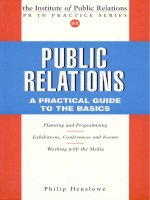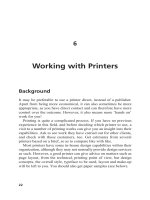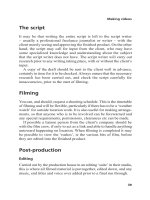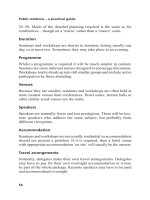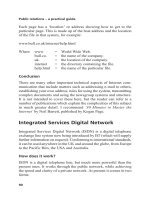Public relations a practical guide to the basics_1 docx
Bạn đang xem bản rút gọn của tài liệu. Xem và tải ngay bản đầy đủ của tài liệu tại đây (172.41 KB, 17 trang )
PUBLIC
RELATIONS
A PRACTICAL
GUIDE
Philip Henslowe
319 prelims.p65 13/06/00, 12:201
First published in 1999
Apart from any fair dealing for the purposes of research or private study, or
criticism or review, as permitted under the Copyright, Designs and Patents
Act 1988, this publication may only be reproduced, stored or transmitted,
in any form or by any means, with the prior permission in writing of the
publishers, or in the case of reprographic reproduction in accordance with
the terms and licences issued by the CLA. Enquiries concerning reproduction
outside those terms should be sent to the publishers at the undermentioned
address:
Kogan Page Limited
120 Pentonville Road
London N1 9JN
© Philip Henslowe, 1999
The right of Philip Henslowe to be identified as the author of this work has
been asserted by him in accordance with the Copyright, Designs and Patents
Act 1988.
British Library Cataloguing in Publication Data
A CIP record for this book is available from the British Library.
ISBN: 0 7494 2937 2
Typeset by JS Typesetting, Wellingborough, Northants
Printed and bound by Clays Ltd, St Ives plc
Dedicated to my wife, Elizabeth
319 prelims.p65 13/06/00, 12:202
Apart from any fair dealing for the purposes of research or private study, or criticism or review, as permitted under the relevant copyright,
designs and patents acts, this publication may only be reproduced, stored or transmitted, in any form or by any means, with the prior
permission in writing of the publisher. eBooks Corporation
Contents
Foreword ix
Preface xi
Acknowledgements xii
1 The roles of public relations 1
Introduction 1
Images 2
Knowledge and understanding 3
Interest 3
Acceptance 3
Sympathy 4
2 External public relations sources 5
Introduction 5
Consultancies 5
Why use a consultancy? 6
Types of consultancy 7
Advantages of using a consultancy 8
Disadvantages of using a consultancy 8
Mixing and matching 9
iv
3 Ethics and the law 10
Ethics 10
Codes of conduct 11
The law 11
Copyright law 13
4 Working with suppliers 16
The brief 16
The contract or agreement 17
Timetabling 17
Costings 18
Progress chasing 18
5 Working with publishers 19
The brief 19
The contract 20
The manuscript 20
Promotion and distribution 21
6 Working with printers 22
Background 22
The brief and the contract 23
Illustrations 23
Paper specification 23
7 Working with photographers 24
Choosing a photographer 24
Photographic libraries 25
Colour or black and white? 26
Location and studio work 26
Contact sheets or transparencies 28
Special effects 28
Assignment of copyright 29
Reproduction studios 30
Contents
v
8 Working with designers 31
Background 31
Desktop publishing 32
The brief 32
The work 33
Conclusion 36
9 Making videos 37
Introduction 37
The film makers 37
Costs 38
The concept 38
The script 39
Filming 39
Post-production 39
10 Exhibitions and other events 41
Exhibitions and trade fairs 41
Support at the stand 42
Setting up and running your own stand 43
Organizing an exhibition 48
Conclusion 49
11 Promotions and functions 50
Venues 50
The programme 51
The characteristics and categories of events 52
Conferences 52
Seminars and workshops 55
12 Visits 58
VIP visits 59
Royal visits 59
13 Sponsorship and educational activities 60
Patronage 60
Sponsorship 61
Contents
vi
Why sponsor? 63
Forms of sponsorship 64
The National Lottery 66
Evaluation 67
14 Business writing 68
General rules 68
Reports and proposals 69
Memoranda 69
Minutes 69
Feature articles 70
15 Crisis management 75
What is crisis management? 76
How to cope 76
After it is over 78
16 Working with the media 80
Impact 80
Audiences 81
Television 81
Opportunities for coverage using television 82
Radio 83
Opportunities for coverage using radio 84
Teletext and Ceefax 85
17 New developments in technology 87
The Internet 87
Electronic mail 88
The World Wide Web 89
Integrated Services Digital Network 90
Digital photography and scanning 91
18 Planning and programming 92
Why have a programme? 92
The programme 93
How to plan the programme 95
Contents
vii
19 Assessment and evaluation 96
Assessment 96
Evaluation 97
Conclusion 100
20 Conclusion 101
Further reading 103
Appendix 1 The Institute of Public Relations Code of
Professional Conduct 105
Appendix 2 The law as it affects public relations practitioners 113
Appendix 3 Model client agreement 117
Appendix 4 Employment law 124
Appendix 5 Checklist of public relations assistance on the
exhibition stand 126
Appendix 6 Event and conference planning 128
Appendix 7 Planning guidelines events 129
Appendix 8 Planning guidelines conferences 130
Appendix 9 VIP visits 132
Appendix 10 Royal visits 134
Appendix 11 Written reports 136
Appendix 12 Agenda format 137
Appendix 13 Example of layout for an internal paper 138
Appendix 14 Example of layout for minutes 140
Appendix 15 Contingency planning for a crisis 142
Index 145
Contents
ix
Foreword
So, you are absolutely new to your first job and it has something to
do with public relations. Or maybe you work in an organization that
hasnt really done public relations and youve been asked to get on
with it. The problem is, youre not sure what to do.
Perhaps you work for a charity or voluntary organization that cannot
afford a public relations professional and you need to become familiar
with whats involved. This book is for you. Philip Henslowe gives a
basic introduction to public relations and introduces some very useful
How tos. This isnt a detailed guide, neither does it pretend to give
any more than an overview, but as an in to the public relations
discipline, it gives a solid base to work from.
Philip provides the legal and ethical framework of public relations
practice and then goes on to indicate how those involved in public
relations work with other fellow professionals who act as suppliers,
photographers, printers, designers and the media (including video
makers). He then goes on to describe how to organize exhibitions,
displays and functions and includes a useful section on Royal visits.
One of the key tasks of practitioners is of writing. Again, Philip takes
the practical approach to business writing, copy and feature writing
and devotes a whole section to this skill. There is also useful guidance
on sponsorship, crisis management, working with the media and on
planning and evaluating campaigns.
x
What the book does not do is cover all the functional areas of public
relations such as internal communications, marketing communications,
public affairs and the like. There are plenty of books around that do
this job. Philip is aiming to provide the potential practitioner with a
raft of knowledge and skills that underpin the range of public relations
activity.
Thus the book fulfills its brief. It is a basic guide for all who wish
to work in the public relations area whatever their future specialism
may be.
Anne Gregory
Series Editor
IPR/Kogan Page
Foreword
xi
Preface
Public relations is not, nor should it be, a stand-alone profession, in
isolation from the rest of the business world. It is connected directly
or indirectly to other professions, and often encompasses many differ-
ent areas marketing, advertising and market research, to name but
three.
Therefore those of us who work in public relations today are
expected to be aware of all the other areas on which our work
impinges. While this does not necessarily mean that we have to be
expert in these areas, nevertheless we should have a good working
knowledge of them, in order to recognize and appreciate the special
problems, specialist skills and knowledge that are required in the
different disciplines with which we have to work.
This book has been written not only for those already working in
public relations, but also for those who are coming into the industry.
It is not meant to be encyclopaedic in its content, but to be used as a
reference. It gives an overview of most of the main areas of work,
with some detail where appropriate, or refers the reader to other, more
detailed works that are available.
In this respect it is hoped that this book will become a useful
signpost to the library of public relations work.
Philip Henslowe
xii
Acknowledgements
In putting together this book, the author has drawn both on his own
experience and that of others, together with the many published works
in this field, and acknowledges the help and assistance he has obtained
from all these sources.
He is particularly indebted to Professor Sam Black, the late Frank
Jefkins, Anne Gregory, Neil King, the Bournville Village Trust and
Ikon Design Limited, for the use of some of their material, as well as
to Bert Hackell (Gemini of the Birmingham Post) for his cartoons.
For more detailed treatment of some areas of public relations work,
refer to further reading on page 103.
1
1
The Roles of Public Relations
Introduction
It is not the authors intention in this introduction to do more than
remind the reader of a few basic facts about public relations generally,
and of its importance to us in our work and in our lives.
Public relations plays a part in a wide variety of ways throughout
all our lives. It is always there. We use it all the time, often without
realizing, in many different ways, depending on our particular needs
at the time. If used properly it can inform, educate, reassure, evoke
sympathy, arouse interest in or an acceptance of situations.
Similarly, in the world of business, public relations affects all types
of organizations, large or small, whether commercial or non-commercial,
charitable or in the public sector. It is about communication in the
broadest sense between an organization and all those with whom it
has any form of contact. It cannot be avoided, or ignored.
However, the term public relations is often either misunderstood
or deliberately misinterpreted, so that it is used in a pejorative way,
associating it with propaganda, economy of the truth or evasion.
Different people therefore have different perceptions of public
relations. Those who work in the industry are often viewed with
suspicion by those who work in the media, who misunderstand its
Public relations – a practical guide
2
roles. There are some individuals, often highly placed in industry,
who expect public relations to be used as a tool for whitewashing
reputations, or for covering up acts of ineptitude or dishonesty.
What then, are the roles of public relations?
Images
An important part of public relations work is the image. What is
meant by image? It can be defined as being: The impression gained
according to the level of knowledge and understanding of facts (about
people, products or situations). Wrong or incomplete information will
give a wrong image. For example, people often refer to India,
meaning the whole sub-continent, whereas in fact India is only part
of it, together with Pakistan and Bangladesh, both independent states
in their own right.
Different images
There are several different sorts of image, all of which have roles for
public relations:
l the mirror image what we think we look like often an illusion
due to wishful thinking.
l the current image what people outside think of an organization,
or a person. Often this image is due to misunderstanding, lack of
knowledge and understanding, or even to hostility.
l the wish image the image that the organization wishes to
achieve. This type of image mostly applies to something new.
l the corporate image the image of an organization. This is very
important in public relations terms, and is made up of many facts,
such as its history, reputation, stability, financial success etc. The
corporate image is how an organization presents itself to the
outside world.
l the multiple image sometimes organizations have different divi-
sions, with each having its own, quite separate corporate identity,
or image. This can be confusing to the public, but can be overcome
by using symbols, badges or other means to provide an identifiable
group image.
3
The roles of public relations
If public relations is not used to correct possible misconceptions and
illusions given out by these different images they can have a damaging
effect on the reputation of the organization concerned by confusing
its public.
Knowledge and understanding
Public relations has a key role to play in helping to inform both its
own public and other, far wider ones, by providing information in a
factual, easily understood format, so that ignorance of an organization,
a product or a place can be overcome through knowledge and
understanding.
A good example of this has been the increasing use of public
relations by many charities, housing associations and other voluntary
bodies in recent years, both to inform the media and the public, and
to explain the nature of their work and their activities generally. This
they have done very successfully.
Interest
Public relations also has a role to play in generating public interest in
a particular situation, or set of circumstances, that may be having a
major affect on an organization or group of people. Using public
relations methods and techniques in this instance can be very effective.
Acceptance
People may be hostile to a situation because they simply do not
understand what is happening, or why. Once they do understand, they
will often much more readily accept it. Public relations has a clear
role to play in explaining the particular situation or circumstances
clearly, so that the ignorance, and even hostility, surrounding it can
be turned into understanding and acceptance.
Public relations – a practical guide
4
Sympathy
The role here for public relations is to promote understanding and
knowledge of the facts about a set of circumstances or a situation in
such a way as to gain sympathy for it. Clearly presented, unbiased
information can often be the way to do this.
Poor images come from ignorance, prejudice, hostility and apathy.
Public relations can convert these into knowledge and under-
standing, acceptance and interest.

